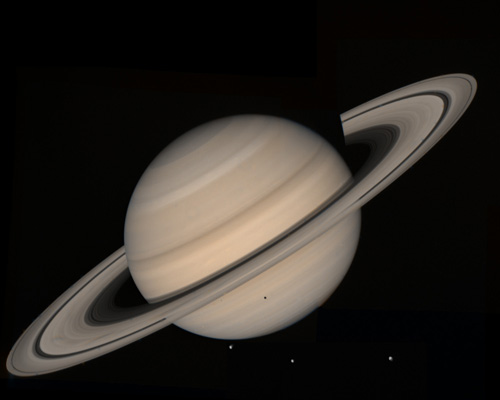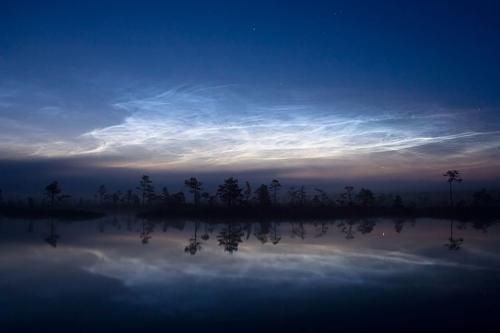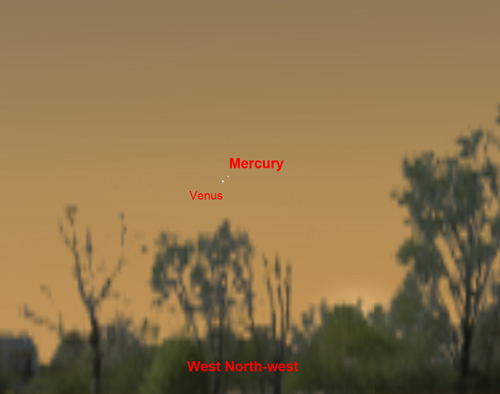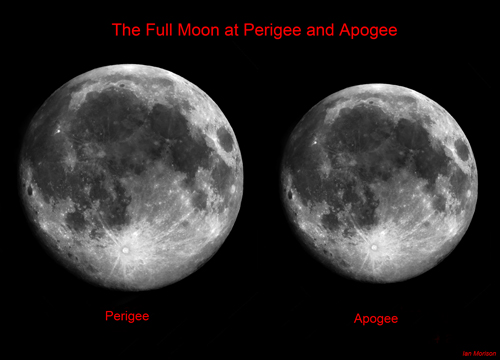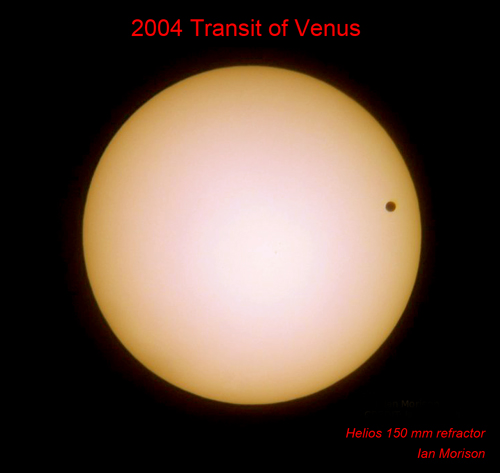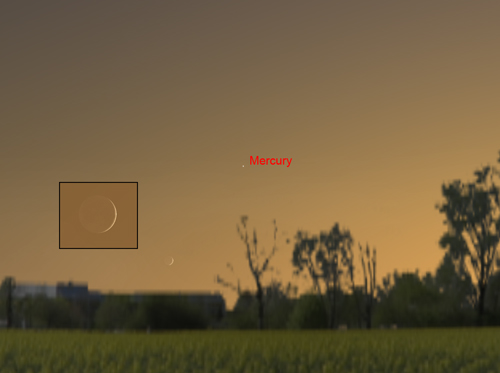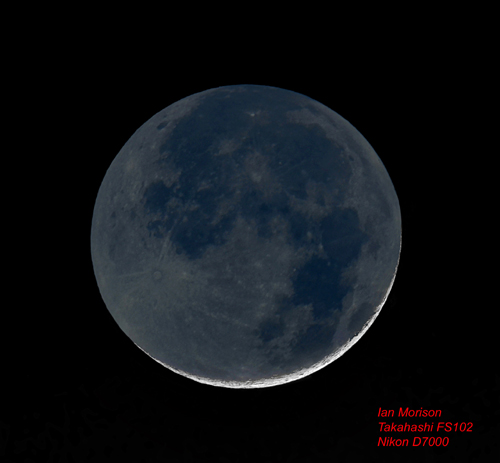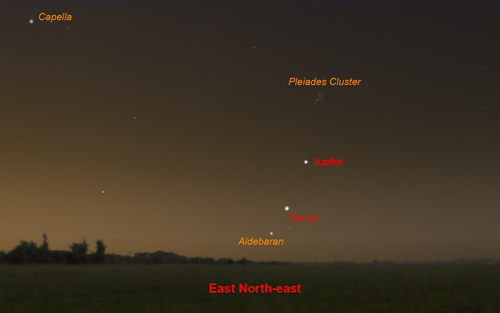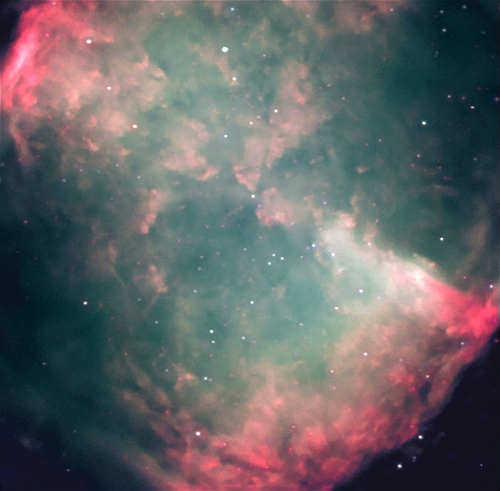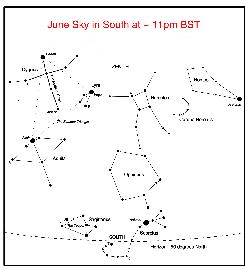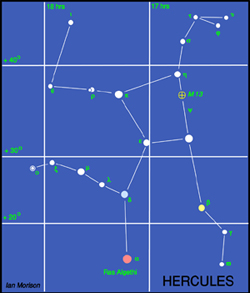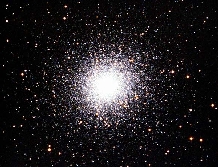The Night Sky June 2012
Compiled by Ian Morison
The last Transit of Venus this Century
This page, updated monthly, will let you know some of the things that you can look out for in the night sky. It lists the phases of the Moon, where you will see the naked-eye planets and describes some of the prominent constellations in the night sky during the month.
Image of the Month
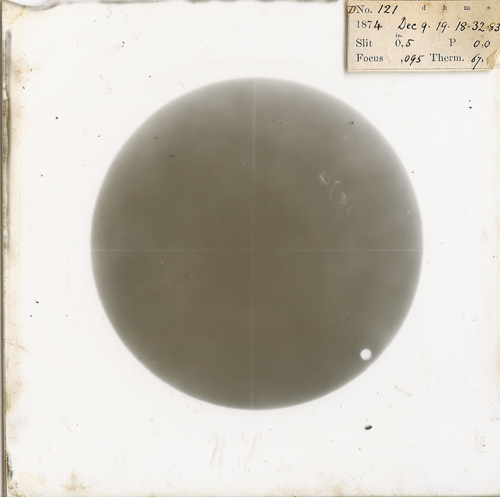
The 1874 Venus Transit
Jessica Ratcliff - STFC, UK
This is an image of the 1874 transit taken by the British expedition at Burnham near Christchurch, New Zealand, and scanned by Jessica Ratcliff from a plate provided by the Science and Technologies Facilities Council. The objective of these observations was to measure the parallax of Venus and hence determine its distance. This provided a scale for the solar system and so gave a value of the Earth-Sun distance known as the Astronomical Unit.
Johannes Kepler was the first astronomer to predict a Venus transit - that of 6th December 1631, but there is no record of it having been observed. Using Kepler's tables, Jeremiah Horrocks realised that a transit would occur on November 24th 1639 and observed it from Much Hoole in Lancashire. He alerted his friend William Crabtree who observed it from Mancheter and it is believed that these were the only people to witness it.
Edmund Halley, the second Astronomer Royal, realised that Venus transits could be used to measure the distance between the Earth and Venus - and hence that of the Sun - and the transits of Venus in 1761 and 1769 were observed across the world. Perhaps the most famous expedition was that of Captain Cook to Tahiti in 1769. Following the observations, Cook opened sealed orders that told him to search for the, then unknown, southern continent, Terra Australis Incognita. As a result, he claimed New Zealand for the Brirish Crown and the land he called New South Wales.
As this year, in 1874 Australia and New Zealand were prime locations to observe the transit - as in the image shown above - and the results gave a value in near agreement with the modern value for the Astronomical Unit. It might be pointed out that the modern value came from radar measurements of the distance of Venus made using the Mk 1 radio telescope at Jodrell Bank and two other radar observatories in the USA and Russia.
See below for details of observing this month's transit from the UK.
Highlights of the Month
June: Still a good month Observe Saturn
To see some of Damian Peache's Saturn Images: Damian Peache's website
Saturn is now in the southern-western sky after sunset. It lies in the constellation Virgo close to the its brightest star Spica. The rings are now ~13 degrees from the line of site and so Saturn appears brighter than for a couple of years, but it will not be until 2018 that they will be at their widest again. It is one of the most beautiful objects in the heavens and though you will never see all the detail that is shown in the Cassini images - or even those made by Damian Peache - your first view of Saturn and its rings will never be forgotten. It takes Saturn 29.4 years to complete one orbit. Due to the tilt of its rotation axis, for half this time we see the northern hemisphere best and for the other half the southern hemisphere. Following the time when we saw the rings edge on a year or so ago, we are now seeing the northern hemisphere. Though not as prominent as those in Jupiter's atmosphere, there are belts and zones in the which can be seen. The belts are thought to be warmer gasses low down in the atmosphere whilst the brighter zones are thought to be ice crystals and clouds in the upper, colder, atmosphere. A small telescope will show the two brightest rings, the outer A ring and the closer in B or Bright ring. These are separated by Cassini's Division. With a ~8" aperture telescope and a night of good seeing, one may also spot Encke's division towards the outer edge of the A ring. A small telescope will also easily show its largest moon, Titan. See further details below in the "Planets" section.
June: Observe Noctilucent Clouds
June is the month for observing Noctilucent clouds high (about 80 km altitude) in the Earth's atmosphere. They appear as bright, whitish-blue whisps above the north, north-western and north-eastern horizons and are most obvious after midnight. They are illuminated by the Sun which is, this month, not far below the horizon towards the north. They appear to be more prominent than in the past (and were not observed until the mid-19th century) and may be associated with the fact that there is now more methane in the atmosphere. This can dissociate into water vapour in the high atmosphere allowing ice clouds to form where, otherwise, it would be too dry. If you do observe them, noting the time and elevation at which they are seen, please submit your observations to Tom McEwan's NLC site: www.nlcnet.co.uk/.
June 1st: Venus and Mercury just 12 arc minutes apart
Just after sunset on the evening of the 1st June, given clear slies and a low horizon towards the west north-west, you may be able to use binoculars to spot Venus (magnitude -4.1) and Mercury (magnitude -1.8) just 12 arc minutes apart. Make sure that you do not use the binoculars when the Sun is still visible!
June 3rd/4th evenings : Another Super Moon
This month, the full Moon occurs just 22 hours after perigee - the point in its orbit when it is closest to the Earth. So, on the evenings of the 3rd and 4th of June, the full Moon will be close to having its largest angular diameter. The Moon has an elliptical orbit and thus its distance from the Earth varies by about 12%. The image shows how this effects the apparent size of the Moon in the Sky - it's quite surprising! Hopefully, we will be able to see the Moon as it rises on these two evenings when the "Moon Illusion" will make it appear very big. The cause of this illusion is disputed, but many believe that it is due to the fact that we perceive the sky as forming a flattened, rather than a hemispherical, dome above us. We thus believe that objects near the horizon are further away and our minds make them appear larger than when we "believe" that we are seeing them closer to us.
When the full Moon is close to perigee the angular diameter of the Moon exceeds 33 arc minutes and its diameter is 12% larger than when at apogee. This makes the apparent area around 30% greater than when we see the full Moon close to apogee. Quite a difference!
June 6th dawn: The Transit of Venus
At dawn on the 6th of June we may be able to see the final stages of the second, and last, transit of Venus, this Century. The first contact - when the disk of Venus first touches the Sun's limb - occurs at 11:10 BST so not visible from the UK and, sadly, by the time the Sun rises, the transit will be nearly over. One will thus need to be up very early and go to a location with a clear view of the north-eastern horizon where the Sun will rise. Dawn occurs at different times across the UK and the more of the transit will be visible the further north and east one can observe it from. Dawn is at 04:30 BST in Edinburgh, but 15 minutes later in London and 45 minutes later in Penzance!
Sunrise (British Summer Time):
Edinburgh 04:30
Leeds 04:38
London 04:46
Belfast 04:51
Cardiff 04:58
The third contact - when Venus's disk just touches the Sun's limb is at 05:37 BST and 4th contact - when the disk leaves the Sun is at 05:55 BST. These times are for London and vary very slightly dependent on your location due to parallax effects. It was the slight differences in the times of contact as seen from different locations across the world that allowed some of the first (reasonably) accurate measurements of the scale of the solar system to be measured.
Never look directly at the Sun! A safe way to observe the transit is to mount a small pair of (cheap) binoculars at one end of a shoe box and project the image of the Sun onto the interior of the other end. If using a telescope to project a solar image be aware that the Sun's heat can damage the eyepiece that is being used! Astronomy shops may be able to sell you "eclipse glasses" with suitable filters to protect your eyes. The disk of Venus is about 1/32 of the diameter of the Sun, so can be seen with these glasses.
June 21st after sunset: Mercury and a thin crescent Moon
After sunset on the 21st, Mercury is at its highest in the sky and is joined by a thin crescent Moon down to its left. You will need a good low horizon north of west to observe them. Look out for the "earthshine" illuminating the "dark side" of the Moon - often called the "old Moon in the new Moon's arms".
June 29th: Venus and Jupiter in the pre-dawn sky
Following its superior conjunction - and transit - on the 6th June, Venus appears in the pre-dawn sky towards the end of the Month. On the 29th, it lies within the Hyades Cluster close to Aldebaran and below Jupiter and the Pleiades Cluster. Note: For clarity, the sky brightness has been reduced in the image. Binoculars will help find them but do not use them after the Sun has risen!
A Messier Object imaged with the Faulkes Telescope: Messier 27 - The Dumbell Nebula
The Dumbell Nebula, imaged by Nik Szymanek.
This image was taken using the Faulkes Telescope North by Nik Szymanek - one of the UK's leading astro-photograpers. M27 is a planetary nebula, the result of a "nova" expolsion at the end of the life of a star like our Sun. The core at the centre of the star collapes under gravity until it is about the size of the Earth when "electron degeneracy pressure", resulting from the fact that electrons do not like being squashed too close together, prevents further collapse. This is called a "white dwarf". As the dying ember of a nuclear fusion reactor, they are exceedingly hot, but will gradually cool over time. The outer parts of the star are expelled at high speed into space resulting in the (in this case) spherical nebula surrounding the white dwarf. The field of the view of the CCD array on the Faulkes Telesocpe is a little too small to encompass the whole nebula. Once, with a 16 inch telescope under perfect conditions, I visually observed M27 and its central part appeared a vivid iridescent green - the only time I have ever seen colour in a deep sky object!
Learn more about the Faulkes Telescopes and how schools can use them: Faulkes Telescope"
Observe the International Space Station

The International Space Station and Jules Verne passing behind the Lovell Telescope on April 1st 2008.
Image by Andrew Greenwood
Use the link below to find when the space station will be visible in the next few days. In general, the space station can be seen either in the hour or so before dawn or the hour or so after sunset - this is because it is dark and yet the Sun is not too far below the horizon so that it can light up the space station. As the orbit only just gets up the the latitude of the UK it will usually be seen to the south, and is only visible for a minute or so at each sighting. Note that as it is in low-earth orbit the sighting details vary quite considerably across the UK. The NASA website linked to below gives details for several cities in the UK. (Across the world too for foreign visitors to this web page.)
Note: I observed the ISS three times recently and was amazed as to how bright it has become.
Find details of sighting possibilities from your location from: Location Index
See where the space station is now: Current Position
The Moon

The Moon at 3rd Quarter. Image, by Ian Morison, taken with a 150mm Maksutov-Newtonian and Canon G7.
Just below the crator Plato seen near the top of the image is the mountain "Mons Piton". It casts a long shadow across the maria from which one can calculate its height - about 6800ft or 2250m.
| new moon | first quarter | full moon | last quarter |
|---|---|---|---|
| June 19th | June 27th | June 4th | June 11th |
Some Lunar Images by Ian Morison, Jodrell Bank Observatory: Lunar Images
A World Record Lunar Image
To mark International Year of Astronomy, a team of British astronomers have made the largest lunar image in history and gained a place in the Guinness Book of Records! The whole image comprises 87.4 megapixels with a Moon diameter of 9550 pixels. This allows details as small as 1km across to be discerned! The superb quality of the image is shown by the detail below of Plato and the Alpine Valley. Craterlets are seen on the floor of Plato and the rille along the centre of the Alpine valley is clearly visible. The image quality is staggering! The team of Damian Peach, Pete lawrence, Dave Tyler, Bruce Kingsley, Nick Smith, Nick Howes, Trevor Little, David Mason, Mark and Lee Irvine with technical support from Ninian Boyle captured the video sequences from which 288 individual mozaic panes were produced. These were then stitched together to form the lunar image.
Please follow the link to the Lunar World Record website and it would be really great if you could donate to Sir Patrick Moore's chosen charity to either download a full resolution image or purchase a print.
The Planets
Jupiter
Jupiter passed behind the Sun on May 13th - superior conjunction - so will now be visible in the pre-dawn sky. It rises just 45 minutes before dawn at the beginning of June and can be glimpsed (at magnitude -2) with binoculars just above the eastern horizon. As the month progresses it rises earlier and so the very end of June (rising 2 hours before the Sun) is perhaps the best time to observe it if you do not mind getting up very early! Its angular diameter will be 34 arc seconds and it shines at magnitude -2. It lies between the Hyades and Pleiades in Taurus and comes within 5 degrees of Venus on June 30th.
See highlight above.Saturn
Saturn reached opposition on April 15th and is now seen about 20 degrees above the south-eastern horizon after sunset. It will then have an elevation of some 30 degrees and lie about 5 degrees above the first magnitude star Spica. It halts its westward retrograde motion on the 26th June so remains almost stationary in the sky. Its magnitude drops from +0.5 to +0.7 as June progresses whilst its angular size also falls - from 18.4 to 17.6 arc seconds. Sadly, in contrast to Jupiter, Saturn is heading to the more southerly parts of the ecliptic so, for quite some considerable time, will not be seen high above the horizon from our northern climes. However the rings have opened out nicely and are now ~12.5 degrees to the line of sight - a temporary minimum - so will appear appreciably wider than we have seen during its last apparition. It is now well be worth having a look at its ~18 arc second disk and ring system. With a small telescope on a night of good seeing, you should be able to easily spot Cassini's Division within the ring system, and given a scope with an aperture of 6 inches or greater and a night of excellent seeing one might even spot Encke's division in the outer A-ring and also the inner, elusive, C-ring.
Mercury
Mercury, has a fine, after sunset, apparition during the latter half of the month. It sets about one and a half hours after the Sun shining at magnitude zero. After the Sun has set, search for it about 10 degrees above the horizon with binoculars. It will be half illuminated - termed dichotomy - on June 26th and reaches greatest elongation on July 1st. Its angular size increases from ~7 to ~8 arc econds during the last 10 days of the month.
See highlight above.Mars
Mars,initially lying below the body of Leo, the Lion, is now, sadly, past its best. Moving further away from us, its magnitude fades from +0.5 to to +0.8 during the month as it moves westwards passing from Leo into Virgo on the 20th of June. At the same time its angular diameter shrinks from 8 arc seconds down to 6.6 arc seconds so it is unlikely that a small telescope will enable you to see any surface markings.
Venus
Venus. as highlighted above, Venus is at inferior conjunction on June 6th but might just be spotted (along with Mercury) about six degrees above the north-western horizon after sunset at the very beginning of June. By mid-June, Venus has reappeared into the pre-dawn sky and rises at about 4:30 BST, half an hour before sunrise. It will then shine at magnitude -4.1 and show a very thin crescent phase just 2% illuminated. Pulling further away from the Sun, by month's end it will rise around 3:30 am BST lying within the "V" shaped Hyades cluster close to the star Aldebaran in Taurus. Its angular diameter will have then dropped from 52 arc seconds on the 21st to 45 arc seconds and its disk will be 16% illuminated.
See highlights above.
Find more planetary images and details about the Solar System: The Solar System
The Stars
The late evening June Sky
This map shows the constellations seen towards the south at about 11pm BST in mid June. High over head towards the north (not shown on the chart) lies Ursa Major. As one moves southwards one first crosses the constellation Hercules with its magnificent globular cluster, M13, and then across the large but not prominent constellation Ophiucus until, low above the southern horizon lie Sagittarius and Scorpio. To the right of Hercules lie the arc of stars making up Corona Borealis and then Bootes with its bright star Arcturus. Rising in the east is the beautiful region of the Milky Way containing both Cygnus and Lyra. Below is Aquilla. The three bright stars Deneb (in Cygnus), Vega (in Lyra) and Altair (in Aquila) make up the "Summer Triangle".
The constellation Ursa Major
The stars of the Plough, shown linked by the thicker lines in the chart above, form one of the most recognised star patterns in the sky. Also called the Big Dipper, after the soup ladles used by farmer's wives in America to serve soup to the farm workers at lunchtime, it forms part of the Great Bear constellation - not quite so easy to make out! The stars Merak and Dubhe form the pointers which will lead you to the Pole Star, and hence find North. The stars Alcor and Mizar form a naked eye double which repays observation in a small telescope as Mizar is then shown to be an easily resolved double star. A fainter reddish star forms a triangle with Alcor and Mizar.
Ursa Major contains many interesting "deep sky" objects. The brightest, listed in Messier's Catalogue, are shown on the chart, but there are many fainter galaxies in the region too. In the upper right of the constellation are a pair of interacting galaxies M81 and M82 shown in the image below. M82 is undergoing a major burst of star formation and hence called a "starburst galaxy". They can be seen together using a low power eyepiece on a small telescope.
Another, and very beautiful, galaxy is M101 which looks rather like a pinwheel firework, hence its other name the Pinwheel Galaxy. It was discovered in1781 and was a late entry to Messier's calalogue of nebulous objects. It is a type Sc spiral galaxy seen face on which is at a distance of about 24 million light years. Type Sc galaxies have a relativly small nucleus and open spiral arms. With an overall diameter of 170,000 light it is one of the largest spirals known (the Milky Way has a diameter of ~ 130,000 light years).
Though just outside the constellation boundary, M51 lies close to Alkaid, the leftmost star of the Plough. Also called the Whirlpool Galaxy it is being deformed by the passage of the smaller galaxy on the left. This is now gravitationally captured by M51 and the two will eventually merge. M51 lies at a distance of about 37 million light years and was the first galaxy in which spiral arms were seen. It was discovered by Charles Messier in 1773 and the spiral structure was observed by Lord Rosse in 1845 using the 72" reflector at Birr Castle in Ireland - for many years the largest telescope in the world.
Lying close to Merak is the planetary nebula M97 which is usually called the Owl Nebula due to its resemblance to an owl's face with two large eyes. It was first called this by Lord Rosse who drew it in 1848 - as shown in the image below right. Planetary nebulae ar the remnants of stars similar in size to our Sun. When all possible nuclear fusion processes are complete, the central core collpses down into a "white dwarf" star and the the outer parts of the star are blown off to form the surrounding nebula.
The constellation Hercules
Between the constellation Bootes and the bright star Vega in Lyra lies the constellation Hercules.The Red Giant star Alpha Herculis or Ras Algethi, its arabic name, is one of the largest stars known, with a diameter of around 500 times that of our Sun. In common with most giant stars it varies its size, changing in brightness as it does so from 3rd to 4th magnitude. Lying along one side of the "keystone" lies one of the wonders of the skies, the great globular cluster, M13. Just visible to the unaided eye on a dark clear night, it is easily seen through binoculars as a small ball of cotten wool about 1/3 the diameter of the full Moon. The brightness increases towards the centre where the concentration of stars is greatest. It is a most beautiful sight in a small telescope. It contains around 300,000 stars in a region of space 100 light years across, and is the brightest globular cluster that can be seen in the northern hemisphere.
The constellation Virgo
Virgo, in the south-east after sunset this month, is not one of the most prominent constellations, containing only one bright star, Spica, but is one of the largest and is very rewarding for those with "rich field" telescopes capable of seeing the many galaxies that lie within its boundaries. Spica is, in fact, an exceedingly close double star with the two B type stars orbiting each other every 4 days. Their total luminosity is 2000 times that of our Sun. In the upper right hand quadrant of Virgo lies the centre of the Virgo Cluster of galaxies. There are 13 galaxies in the Messier catalogue in this region, all of which can be seen with a small telescope. The brightest is the giant elliptical galaxy, M87, with a jet extending from its centre where there is almost certainly a massive black hole into which dust and gas are falling. This releases great amounts of energy which powers particles to reach speeds close to the speed of light forming the jet we see. M87 is also called VIRGO A as it is a very strong radio source.
Below Porrima and to the right of Spica lies M104, an 8th magnitude spiral galaxy about 30 million light years away from us. Its spiral arms are edge on to us so in a small telescope it appears as an elliptical galaxy. It is also known as the Sombrero Galaxy as it looks like a wide brimmed hat in long exposure photographs.
The constellations Lyra and Cygnus
This month the constellations Lyra and Cygnus are rising in the East as darkness falls with their bright stars Vega, in Lyra, and Deneb, in Cygnus, making up the "summer triangle" of bright stars with Altair in the constellation Aquila below. (see sky chart above)
Lyra
Lyra is dominated by its brightest star Vega, the fifth brightest star in the sky. It is a blue-white star having a magnitude of 0.03, and lies 26 light years away. It weighs three times more than the Sun and is about 50 times brighter. It is thus burning up its nuclear fuel at a greater rate than the Sun and so will shine for a correspondingly shorter time. Vega is much younger than the Sun, perhaps only a few hundred million years old, and is surrounded by a cold,dark disc of dust in which an embryonic solar system is being formed!
There is a lovely double star called Epsilon Lyrae up and to the left of Vega. A pair of binoculars will show them up easily - you might even see them both with your unaided eye. In fact a telescope, provided the atmosphere is calm, shows that each of the two stars that you can see is a double star as well so it is called the double double!
Between Beta and Gamma Lyra lies a beautiful object called the Ring Nebula. It is the 57th object in the Messier Catalogue and so is also called M57. Such objects are called planetary nebulae as in a telescope they show a disc, rather like a planet. But in fact they are the remnants of stars, similar to our Sun, that have come to the end of their life and have blown off a shell of dust and gas around them. The Ring Nebula looks like a greenish smoke ring in a small telescope, but is not as impressive as it is shown in photographs in which you can also see the faint central "white dwarf" star which is the core of the original star which has collapsed down to about the size of the Earth. Still very hot this shines with a blue-white colour, but is cooling down and will eventually become dark and invisible - a "black dwarf"! Do click on the image below to see the large version - its wonderful!
M56 is an 8th magnitude Globular Cluster visible in binoculars roughly half way between Alberio (the head of the Swan) and Gamma Lyrae. It is 33,000 light years away and has a diameter of about 60 light years. It was first seen by Charles Messier in 1779 and became the 56th entry into his catalogue.
Cygnus
Cygnus, the Swan, is sometimes called the "Northern Cross" as it has a distinctive cross shape, but we normally think of it as a flying Swan. Deneb,the arabic word for "tail", is a 1.3 magnitude star which marks the tail of the swan. It is nearly 2000 light years away and appears so bright only because it gives out around 80,000 times as much light as our Sun. In fact if Deneb where as close as the brightest star in the northern sky, Sirius, it would appear as brilliant as the half moon and the sky would never be really dark when it was above the horizon!
The star, Albireo, which marks the head of the Swan is much fainter, but a beautiful sight in a small telescope. This shows that Albireo is made of two stars, amber and blue-green, which provide a wonderful colour contrast. With magnitudes 3.1 and 5.1 they are regarded as the most beautiful double star that can be seen in the sky.
Cygnus lies along the line of the Milky Way, the disk of our own Galaxy, and provides a wealth of stars and clusters to observe. Just to the left of the line joining Deneb and Sadr, the star at the centre of the outstretched wings, you may, under very clear dark skys, see a region which is darker than the surroundings. This is called the Cygnus Rift and is caused by the obscuration of light from distant stars by a lane of dust in our local spiral arm. the dust comes from elements such as carbon which have been built up in stars and ejected into space in explosions that give rise to objects such as the planetary nebula M57 described above.
Deneb,the arabic word for "tail", is a 1.3 magnitude star which marks the tail of the swan. It is nearly 2000 light years away and appears so bright only because it gives out around 80,000 times as much light as our Sun. In fact if Deneb where as close as the brightest star in the northern sky, Sirius, it would appear as brilliant as the half moon and the sky would never be really dark when it was above the horizon!
There is a beautiful region of nebulosity up and to the left of Deneb which is visible with binoculars in a very dark and clear sky. Photographs show an outline that looks like North America - hence its name the North America Nebula. Just to its right is a less bright region that looks like a Pelican, with a long beak and dark eye, so not surprisingly this is called the Pelican Nebula. The photograph below shows them well.
Brocchi's Cluster An easy object to spot with binoculars in Gygnus is "Brocchi's Cluster", often called "The Coathanger",although it appears upside down in the sky! Follow down the neck of the swan to the star Alberio, then sweep down and to its lower left. You should easily spot it against the dark dust lane behind.


